Polarization-Based Two-Stage Image Dehazing in a Low-Light Environment
Abstract
:1. Introduction
- We propose a two-stage image dehazing method based on polarization to recover the image quality of hazy images from a low-light environment;
- We propose a low-light polarization dehazing dataset which provides an integrated quality evaluation framework for low-light polarization image dehazing;
- The experimental results demonstrate that the proposed method achieves good dehazing results and exhibits significant improvements in terms of image quality, detail restoration, and contrast enhancement.
2. Proposed Method
2.1. Polarization-Based Image Enhancement Module
2.2. Low-Light Polarization Dehazing Module
3. Loss Function
4. Data Preparation
4.1. Data for Polarization-Based Image Enhancement Module
4.2. Data for Low-Light Polarization Dehazing Module
| Algorithm 1 Low-light hazy polarization simulation |
|
4.3. Data for Low-Light Image Dehazing Benchmark
5. Experimental Setup and Results
5.1. Implementation Details
5.2. Results and Discussion
6. Conclusions
Author Contributions
Funding
Data Availability Statement
Conflicts of Interest
References
- Schechner, Y.Y.; Narasimhan, S.G.; Nayar, S.K. Instant dehazing of images using polarization. In Proceedings of the 2001 IEEE Computer Society Conference on Computer Vision and Pattern Recognition. CVPR 2001, Kauai, HI, USA, 8–14 December 2001; Volume 1, pp. 325–332. [Google Scholar]
- Zhou, C.; Teng, M.; Han, Y.; Xu, C.; Shi, B. Learning to dehaze with polarization. Adv. Neural Inf. Process. Syst. 2021, 34, 11487–11500. [Google Scholar]
- Fang, S.; Xia, X.; Huo, X.; Chen, C. Image dehazing using polarization effects of objects and airlight. Opt. Express 2014, 22, 19523–19537. [Google Scholar] [CrossRef] [PubMed]
- Namer, E.; Shwartz, S.; Schechner, Y.Y. Skyless polarimetric calibration and visibility enhancement. Opt. Express 2009, 17, 472–493. [Google Scholar] [CrossRef] [PubMed]
- He, K.; Sun, J.; Tang, X. Single image haze removal using dark channel prior. IEEE Trans. Pattern Anal. Mach. Intell. 2010, 33, 2341–2353. [Google Scholar] [PubMed]
- Zheng, Y.; Zhan, J.; He, S.; Dong, J.; Du, Y. Curricular contrastive regularization for physics-aware single image dehazing. In Proceedings of the IEEE/CVF Conference on Computer Vision and Pattern Recognition, Vancouver, BC, Canada, 17–24 June 2023; pp. 5785–5794. [Google Scholar]
- Song, Y.; He, Z.; Qian, H.; Du, X. Vision transformers for single image dehazing. IEEE Trans. Image Process. 2023, 32, 1927–1941. [Google Scholar] [CrossRef] [PubMed]
- Dong, H.; Pan, J.; Xiang, L.; Hu, Z.; Zhang, X.; Wang, F.; Yang, M.H. Multi-scale boosted dehazing network with dense feature fusion. In Proceedings of the IEEE/CVF Conference on Computer Vision and Pattern Recognition, Seattle, WA, USA, 13–19 June 2020; pp. 2157–2167. [Google Scholar]
- Zhu, M.; He, B.; Wu, Q. Single image dehazing based on dark channel prior and energy minimization. IEEE Signal Process. Lett. 2017, 25, 174–178. [Google Scholar] [CrossRef]
- John, J.; Sevugan, P. Image Dehazing Through Dark Channel Prior and Color Attenuation Prior. In Proceedings of the Advances in Computing and Data Sciences: 5th International Conference, ICACDS 2021, Nashik, India, 23–24 April 2021; Revised Selected Papers, Part II 5. Springer: Berlin/Heidelberg, Germany, 2021; pp. 147–159. [Google Scholar]
- Shi, D.; Huang, F.; Jia, L.; Niu, Y.; Chen, S.; Jiao, L.; Huang, Y.; Liu, L. Research on the dehazing effect of orthogonal polarization method based on atmospheric scattering model and considering extinction ratio parameter. Int. J. Remote Sens. 2024, 45, 1556–1573. [Google Scholar] [CrossRef]
- Hu, H.; Lin, Y.; Li, X.; Qi, P.; Liu, T. IPLNet: A neural network for intensity-polarization imaging in low light. Opt. Lett. 2020, 45, 6162–6165. [Google Scholar] [CrossRef] [PubMed]
- Xu, X.; Wan, M.; Ge, J.; Chen, H.; Zhu, X.; Zhang, X.; Chen, Q.; Gu, G. ColorPolarNet: Residual dense network-based chromatic intensity-polarization imaging in low-light environment. IEEE Trans. Instrum. Meas. 2022, 71, 1–10. [Google Scholar] [CrossRef]
- Zhou, C.; Teng, M.; Lyu, Y.; Li, S.; Xu, C.; Shi, B. Polarization-aware low-light image enhancement. In Proceedings of the AAAI Conference on Artificial Intelligence, Vancouver, BC, Canada, 20–27 February 2023; Volume 37, pp. 3742–3750. [Google Scholar]
- Guo, C.; Li, C.; Guo, J.; Loy, C.C.; Hou, J.; Kwong, S.; Cong, R. Zero-reference deep curve estimation for low-light image enhancement. In Proceedings of the IEEE/CVF Conference on Computer Vision and Pattern Recognition, Seattle, WA, USA, 13–19 June 2020; pp. 1780–1789. [Google Scholar]
- Zhang, X.; Wang, X. MARN: Multi-scale attention retinex network for low-light image enhancement. IEEE Access 2021, 9, 50939–50948. [Google Scholar] [CrossRef]
- Wei, K.; Fu, Y.; Yang, J.; Huang, H. A physics-based noise formation model for extreme low-light raw denoising. In Proceedings of the IEEE/CVF Conference on Computer Vision and Pattern Recognition, Seattle, WA, USA, 13–19 June 2020; pp. 2758–2767. [Google Scholar]
- Li, L.; Wang, R.; Wang, W.; Gao, W. A low-light image enhancement method for both denoising and contrast enlarging. In Proceedings of the 2015 IEEE International Conference on Image Processing (ICIP), Quebec City, QC, Canada, 27–30 September 2015; pp. 3730–3734. [Google Scholar]
- Zhang, X.; Wang, X.; Yan, C. LL-CSFormer: A Novel Image Denoiser for Intensified CMOS Sensing Images under a Low Light Environment. Remote Sens. 2023, 15, 2483. [Google Scholar] [CrossRef]
- Kyba, C.C.; Ruhtz, T.; Fischer, J.; Hölker, F. Lunar skylight polarization signal polluted by urban lighting. J. Geophys. Res. Atmos. 2011, 116. [Google Scholar] [CrossRef]
- Xavier Kerola, D. Modelling artificial night-sky brightness with a polarized multiple scattering radiative transfer computer code. Mon. Not. R. Astron. Soc. 2006, 365, 1295–1299. [Google Scholar] [CrossRef]
- Yan, C.; Zhang, X.; Wang, X.; Jiao, G.; He, H. A novel simulation for polarization dehazing. IEEE Signal Process. Lett. 2024, 31, 341–345. [Google Scholar] [CrossRef]

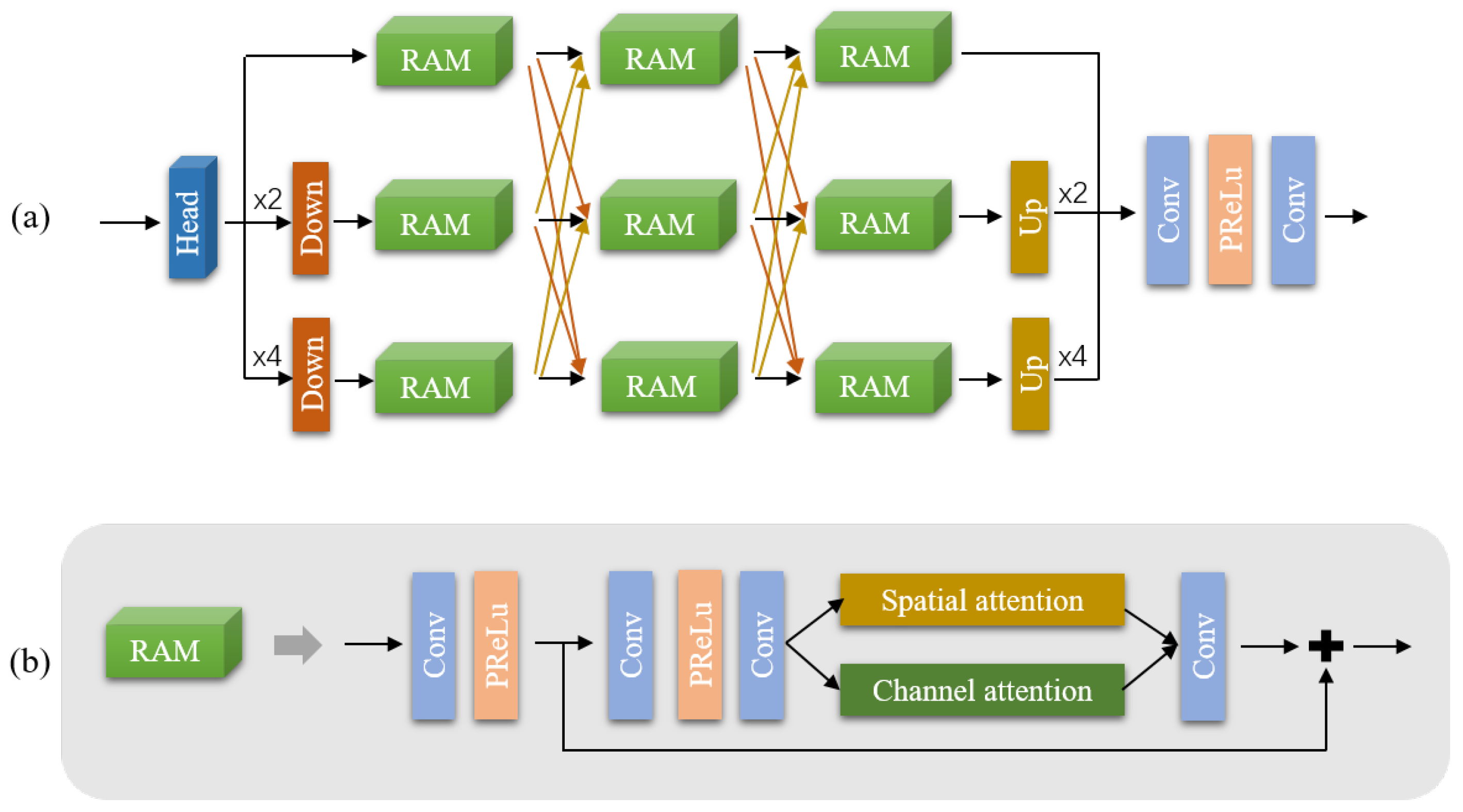

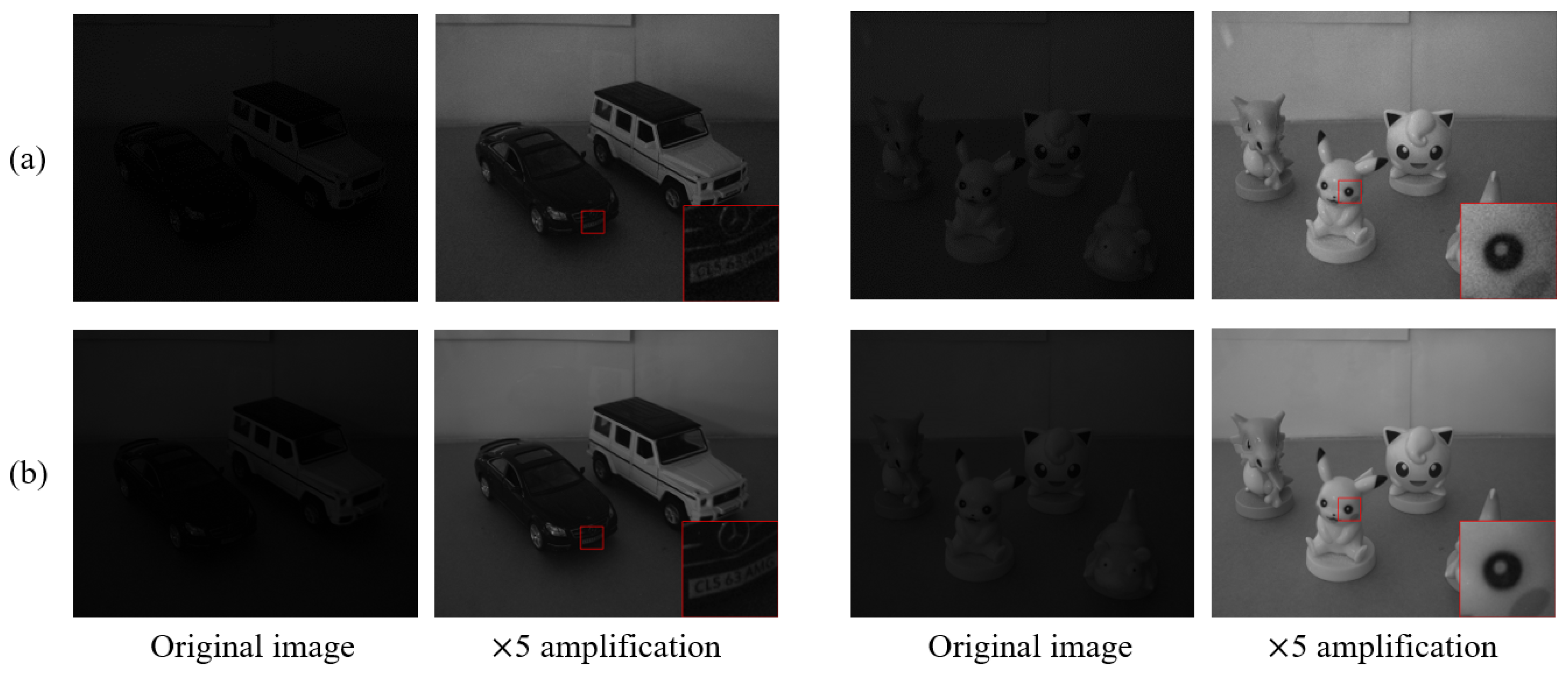

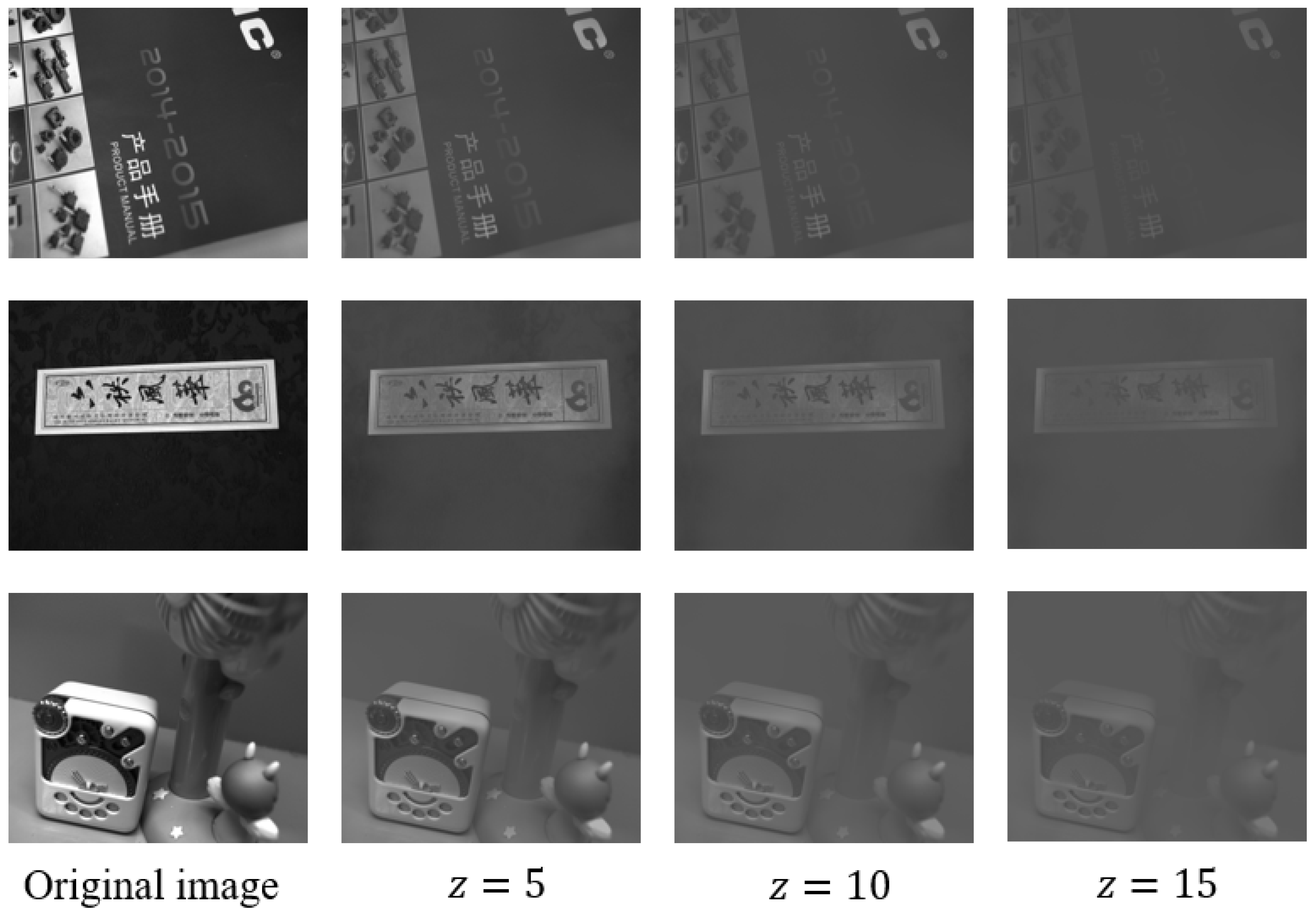
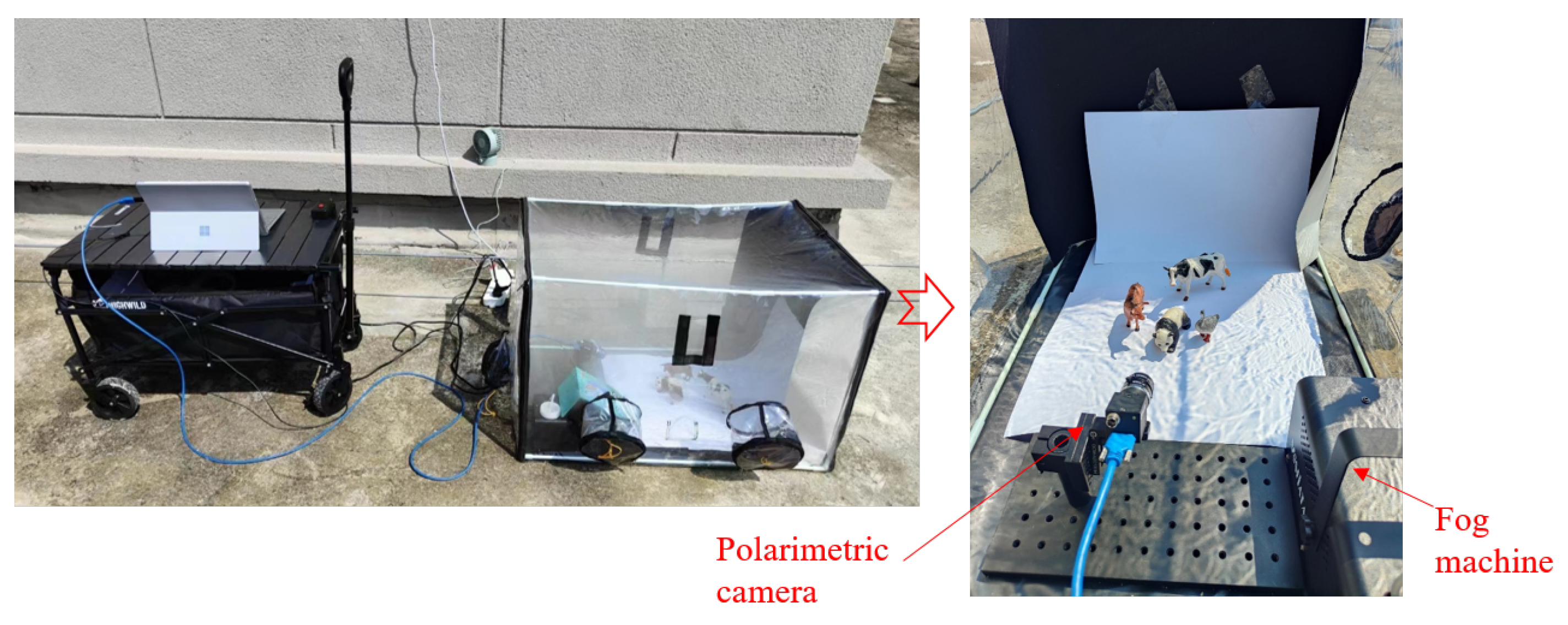

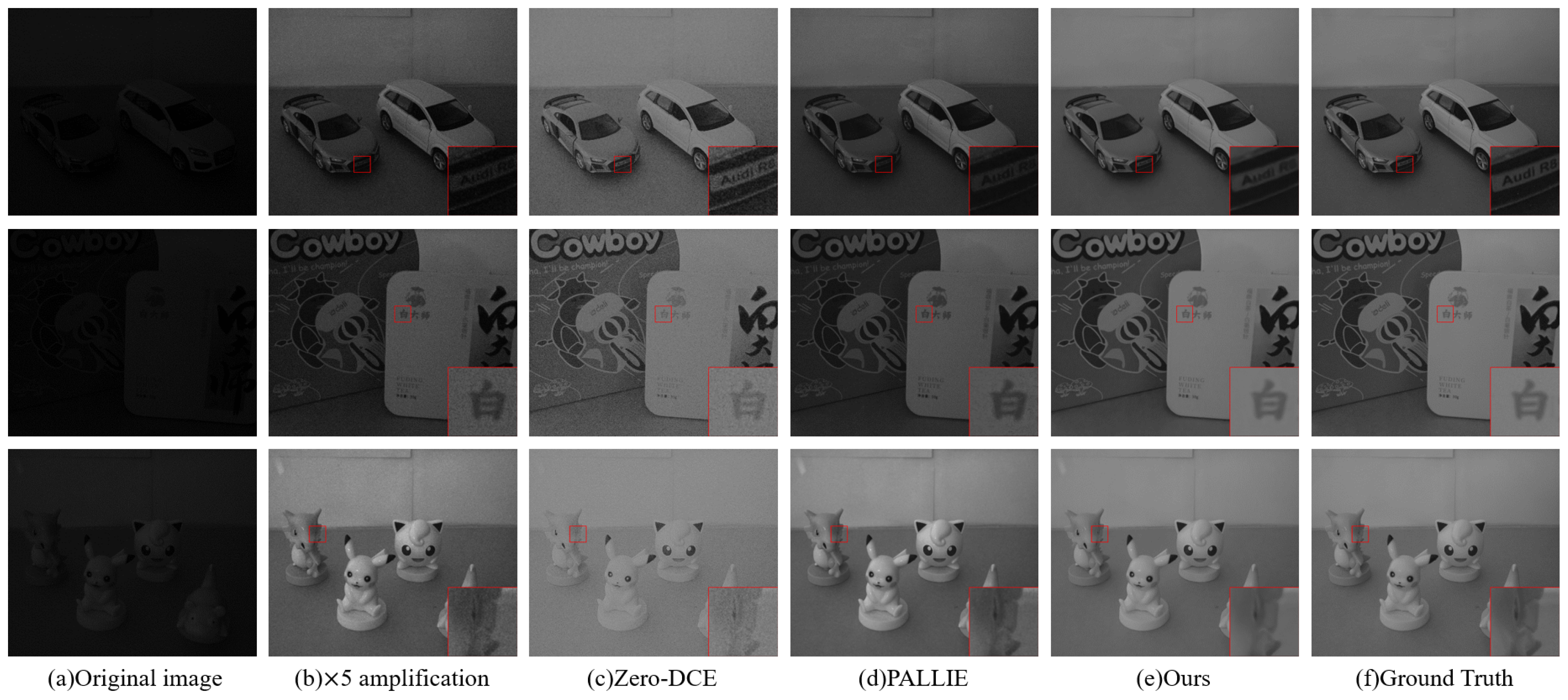
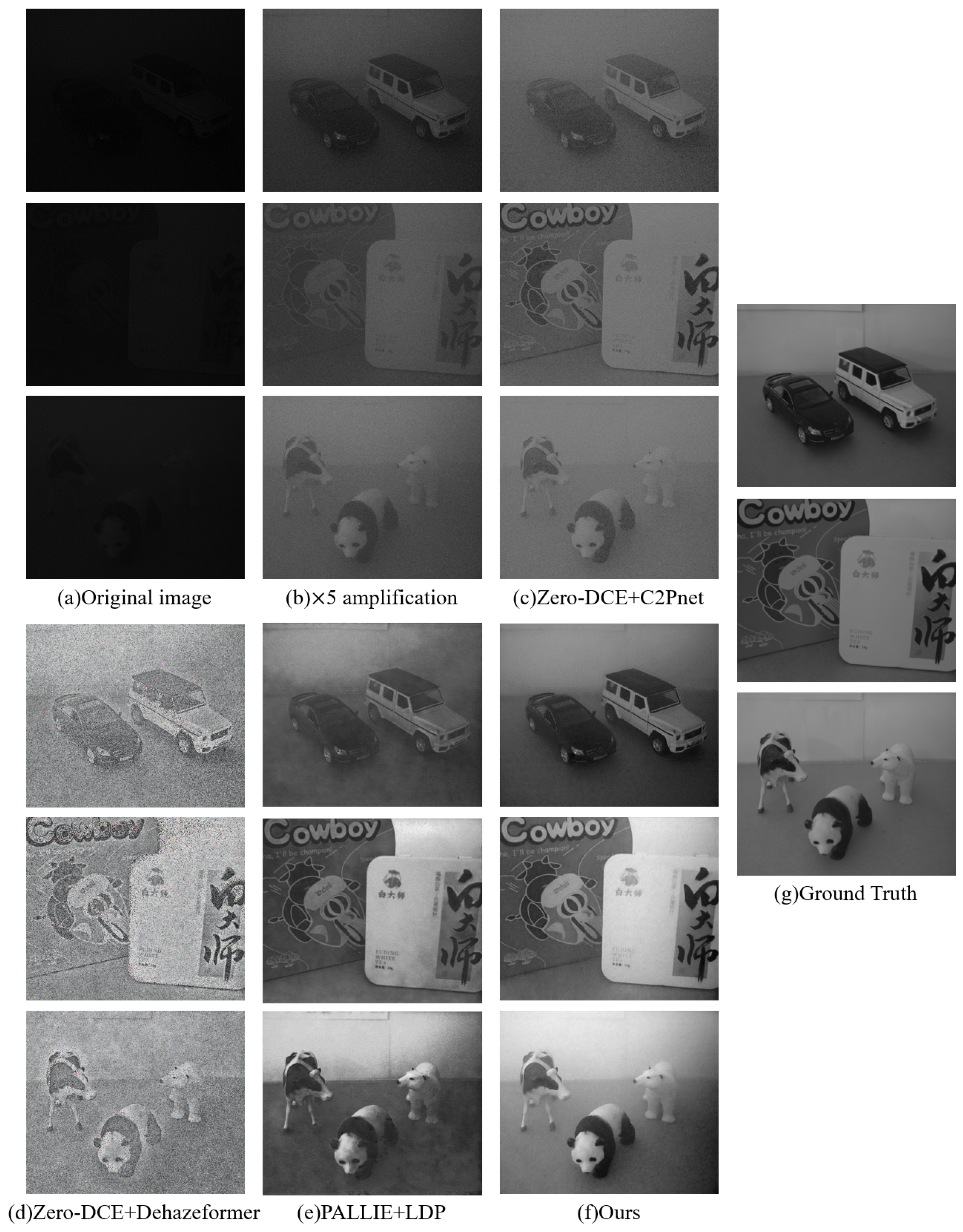
| Method | Amplified | Zero-DCE | PALLIE | Ours |
|---|---|---|---|---|
| PSNR | 21.05 | 22.26 | 23.59 | 37.72 |
| SSIM | 0.5234 | 0.5338 | 0.7861 | 0.9429 |
| DCE + C2Pnet | DCE + D-Former | PALLIE + LDP | Ours | |
|---|---|---|---|---|
| PSNR | 21.07 | 11.62 | 19.21 | 25.38 |
| SSIM | 0.4596 | 0.0563 | 0.5833 | 0.8358 |
Disclaimer/Publisher’s Note: The statements, opinions and data contained in all publications are solely those of the individual author(s) and contributor(s) and not of MDPI and/or the editor(s). MDPI and/or the editor(s) disclaim responsibility for any injury to people or property resulting from any ideas, methods, instructions or products referred to in the content. |
© 2024 by the authors. Licensee MDPI, Basel, Switzerland. This article is an open access article distributed under the terms and conditions of the Creative Commons Attribution (CC BY) license (https://creativecommons.org/licenses/by/4.0/).
Share and Cite
Zhang, X.; Wang, X.; Yan, C.; Jiao, G.; He, H. Polarization-Based Two-Stage Image Dehazing in a Low-Light Environment. Electronics 2024, 13, 2269. https://doi.org/10.3390/electronics13122269
Zhang X, Wang X, Yan C, Jiao G, He H. Polarization-Based Two-Stage Image Dehazing in a Low-Light Environment. Electronics. 2024; 13(12):2269. https://doi.org/10.3390/electronics13122269
Chicago/Turabian StyleZhang, Xin, Xia Wang, Changda Yan, Gangcheng Jiao, and Huiyang He. 2024. "Polarization-Based Two-Stage Image Dehazing in a Low-Light Environment" Electronics 13, no. 12: 2269. https://doi.org/10.3390/electronics13122269






